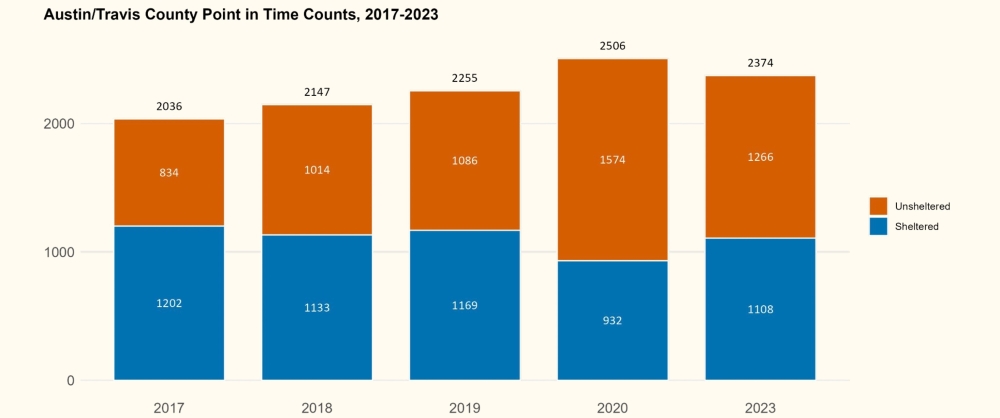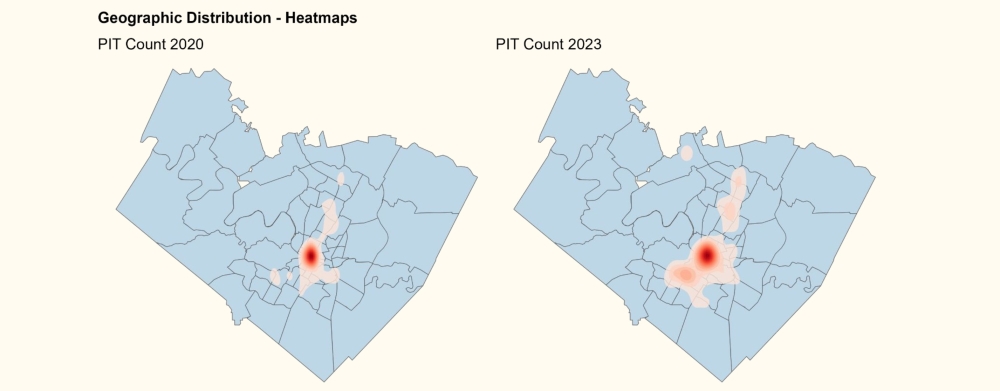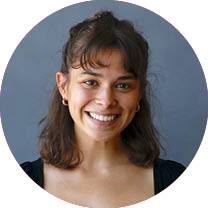The big picture
The Ending Community Homelessness Coalition, a nonprofit leading the regional homelessness strategy, identified new trends in Austin’s homeless community based on a January point-in-time count of unsheltered residents. The count marked the first in-person survey conducted since the COVID-19 pandemic.
Point-in-time counts are federally mandated efforts used to get a snapshot of an area’s homeless population on any given night.
By the numbers
- 2,374 total people experiencing homelessness counted
- 1,266 people counted as unsheltered, or living on the streets and in temporary places such as tents or cars
- 1,108 people counted in shelters or transitional housing

Key findings
- Men and boys had higher rates of homelessness at about 63% of the population counted.
- Black people were overrepresented in the homeless population at about 33% despite making up 7.25% of Austin’s total population, according to the 2020 U.S. census.
- Those 35 to 44 years old were the largest age group identified and were mostly unsheltered.
- Veterans made up 9.5% of those counted.
- The shares of Hispanic, Asian and Native American people experiencing homelessness in 2023 all rose since 2020.
ECHO volunteers counted fewer people in the January survey than in 2020 but about 100 more than the count in 2019. However, ECHO representatives cautioned the totals may be undercounted and don’t offer a full picture of the local homeless population.
Complicating factors include rainy weather on the night of the count and the broad geographic distribution of unsheltered residents, especially in parks and wooded areas. The survey also didn't account for most or all of the 699 homeless people booked in Travis County Jail on Jan. 28, according to the county sheriff's office.
ECHO also maintains a dashboard with monthly estimates of the regional homeless population that's based on the number of people who seek out services or housing. That data, which ECHO staff said may offer a more accurate systemwide view of homelessness, shows a gradually increasing unsheltered population that passed 4,500 people this spring.
Based on that information, around 5,400 people are now experiencing sheltered or unsheltered homelessness in the Austin area.The impact
An increased homeless presence has been tracked toward the city's edges and in less visible places since Austinites voted in May 2021 to reinstate a public camping ban. Analysts and service providers at that time had predicted such a distribution would take place, likely making it harder to find homeless residents and connect them with supportive services and shelter or housing.
The number of people experiencing homelessness in city parks and green spaces rose from 5.2% as of early 2020 to 13.6% in 2023, the January point-in-time count found.
“What we’re seeing though is a significant increase in the number of folks who are ending up in our parks, nature preserves and green belts,” ECHO Executive Director Matt Mollica said during a May 24 presentation. “And that just makes sense, right? Out of the way, more hidden, less likely to be encountered by the police.”

In Austin, City Council District 9, which includes downtown, still claims the highest share of those experiencing homelessness. However, the count in the area dropped by more than a third since 2020.
Conversely, the areas farther from downtown—particularly South Austin’s District 5, Northwest Austin’s District 6 and Northeast Austin’s District 1—saw notable jumps in the number of unsheltered residents over the same time.






